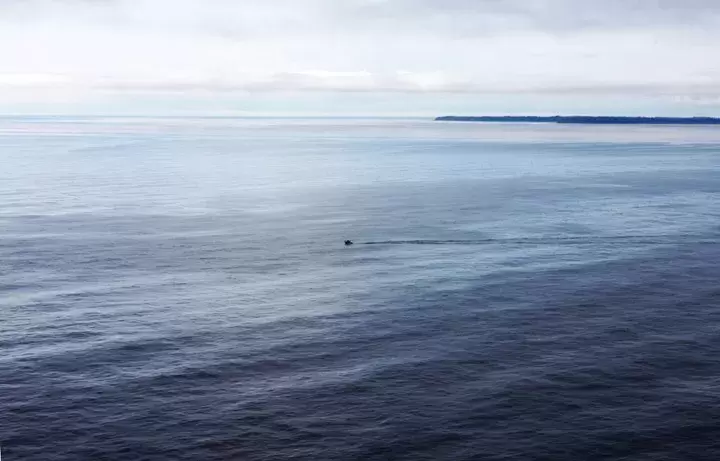It’s a dangerous thing to be playing hot potato with, but that’s what is happening with a canister of Arcton 22 that has come to shore at Hesquiaht, presumably part of the advance items of the Japan tsunami debris field that is heading to the West Coast of North America.
Dave Ignace found the canister on March 2 and pulled it off the beach to above the high tide line, said his wife Dianne in an interview with Ha-Shilth-Sa on May 3. The canister was mostly intact, except for the guard around the valve.
On the canister was Japanese markings and the English name of the product held within. The contents are a hydrochlorofluorocarbon used in air conditioning applications.
Not only is the material bad for the environment (ozone depletion, greenhouse gas, global warming) but it’s also very harmful to humans. It is a known carcinogen, and also extremely dangerous if it touches the skin or if the vapors are inhaled.
A quick Google search shows that the substance “may cause effects on the cardiovascular system and central nervous system, resulting in cardiac disorders and central nervous system depression. Exposure could cause lowering of consciousness.”
Dianne said that they called the Coast Guard right away about the found material; and then they called the hazardous spills 800 number. Then there was the Canadian military, which came out to the area to pick up some of their equipment that had got away from them, but left the canister in its resting spot.
Parks Canada has been brought into the loop, as has Hesquiaht Nation, Ahousaht emergency response and police. And still the canister remains at Hesquiaht.
Dianne said everyone is saying they have no funding to collect such material from this remote place. Unlike the Harley Davidson motorcycle that came ashore on an isolated stretch of beach at Haida Gwaii some weeks back, hydrochlorofluorocarbon doesn’t seem to warrant retrieval.
There were suggestions, however, said Dianne, of what the couple should do with the substance. One agency told them to put it in their boat and take it to Tofino where a Hazmat team could take the substance from them for disposal. Unwilling to do that, the Ignace’s were told that someone could drag the canister behind a boat through open ocean for an hour-and-a-half to Tofino, again to a team wearing protective gear.
The Ignace’s have opted to leave the 50 lbs of hazardous materials tucked in a bush until someone comes to pick it up. When they found the canister they felt the spot would be a safe place until it was retrieved, but Dianne is now worried the area, which is a favorite spot for nature lovers and tourists, is no longer as secure as she would hope.
Curtis Dick, one of two emergency coordinators from Ahousaht, has been leading the charge from Nuu-chah-nulth territory about the potential chaos and economic cost of the large tsunami debris field that is heading this way. He even launched a facebook page called Tsunami Debris watch-West Coast http://www.facebook.com/#!/groups/381807828538248/?bookmark_t=group where he hopes to “share resources, information and thoughts” about the situation the communities up and down the coast will face. He poses six questions on the page, including: Are we ready? Who is in charge? And, when do we get involved?
Dick said he has been “barking up people’s trees” over the last few months and isn’t getting a lot of information about who is going to be responsible for this material as it comes ashore, or even if it’s going to be allowed to come to shore.
Perhaps the goal is to go out and collect the material before it comes onto the beaches, he wondered aloud to Ha-Shilth-Sa. So far, however, there is no plan being communicated from the federal government or the province.
There was a recent meeting of concerned communities along the coast that he attended and the consensus was that all would work together, when the time came. But so far, no direction has been taken. So he’s suggesting that people keep themselves safe from anything that comes to shore. Mark it on a map and leave it.
The West Coast is in limbo, Dick said, as government decides its fate. Jim Standen, assistant deputy minister for the B.C. Ministry of the Environment, was appointed by the province to head the debris field working group on Jan. 9. At that time he told Ha-Shilth-Sa that it would be some time before the committee could come up with a plan.
Dick said that he received an email from Standen in which Dick was told that the committee has met only once. We have contacted Standen for this story and are awaiting a response.
Hesquiaht Chief Councillor Vic Amos suggests that the leadership of the West Coast unite and raise this as a political issue. He said “one individual crying in the wilderness will not be heard, but if the nations from Haida Gwaii to Tsimshian to Nuu-chah-nulth and all the way down the coast got together they would motivate a response from government. He is suggesting the Nuu-chah-nulth Tribal Council take the lead on this political alignment.







